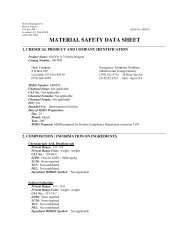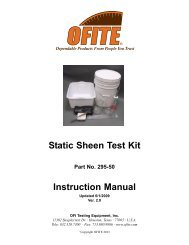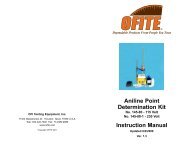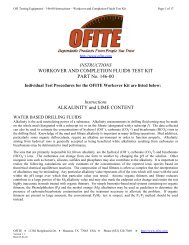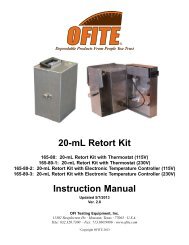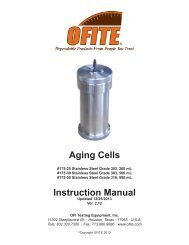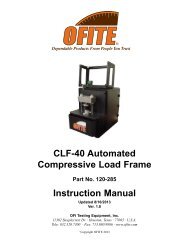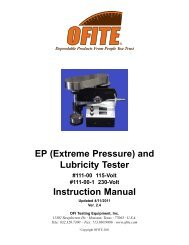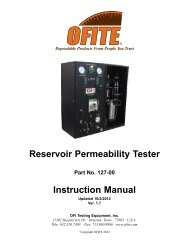English - OFI Testing Equipment, Inc.
English - OFI Testing Equipment, Inc.
English - OFI Testing Equipment, Inc.
You also want an ePaper? Increase the reach of your titles
YUMPU automatically turns print PDFs into web optimized ePapers that Google loves.
Permeability Plugging Tester - P.P.T.<br />
4,000 PSI (27,600 kPa) - 500°F (260°C)<br />
Part No. 171-84 (115V)<br />
Part No. 171-84-01 (230V)<br />
Instruction Manual<br />
Updated 5/6/2011<br />
Ver. 2.2<br />
<strong>OFI</strong> <strong>Testing</strong> <strong>Equipment</strong>, <strong>Inc</strong>.<br />
11302 Steeplecrest Dr. · Houston, Texas · 77065 · U.S.A.<br />
Tele: 832.320.7300 · Fax: 713.880.9886 · www.ofite.com<br />
©<br />
Copyright <strong>OFI</strong>TE 2011
Table of<br />
Contents<br />
Intro....................................................................................................2<br />
Description........................................................................................2<br />
Specifications ...................................................................................3<br />
Components......................................................................................4<br />
Safety.................................................................................................6<br />
Operation ..........................................................................................9<br />
Preparation ...................................................................................9<br />
Loading the Filtration Cell...........................................................10<br />
Test Procedure............................................................................15<br />
Disassembly ...................................................................................16<br />
Reporting Data................................................................................18<br />
Calculations ....................................................................................18<br />
Maintenance....................................................................................19<br />
<strong>OFI</strong>TE, 11302 Steeplecrest Dr., Houston, TX 77065 USA / Tel: 832-320-7300 / Fax: 713-880-9886 / www.ofite.com 1
Intro<br />
Description<br />
The Permeability Plugging Tester (PPT) is a modification of the standard<br />
500-mL HTHP Filter press. It may be used in the field or in a laboratory<br />
environment. The instrument is useful for performing filtration tests on<br />
plugging materials without the interference of particles settling on the filter<br />
medium during the heat up process. The PPT is very useful in predicting<br />
how a drilling fluid can form a low permeable filter cake to seal off depleted,<br />
under pressured intervals and help prevent differential sticking. Typical differential<br />
pressures are much higher than those seen in standard HTHP<br />
testing.<br />
The pressure cell is similar to those seen in standard HTHP filtration testing,<br />
but it is inverted with the filter medium and the back pressure receiver<br />
on top of the assembly. The conventional cell may be operated to 2,000<br />
PSI by using hardened steel set screws to secure the cell cap. For elevated<br />
pressure, <strong>OFI</strong>TE has designed a special cell with a working pressure of<br />
up to 4,000 PSI, pressurized with the conventional hydraulic pump. The<br />
cell is pressurized with hydraulic oil and a floating piston separates the oil<br />
from the test fluid within the cell.<br />
The cell is furnished with a threaded cell inlet cap, a floating piston, and a<br />
threaded scribed outlet cap for the ceramic filter disks. The outlet end of<br />
the cell has a ¼" (6.35 mm) deeper recess than a standard cell to allow for<br />
the ceramic disk as a filter medium. The end cap used with the ¼" (6.35<br />
mm) disk has a scribed concentric pattern rather than the conventional<br />
screen. Filter paper or other thin filter medium may be used with this cap<br />
by using the spacer ring (Part No. 170-72) to fill the extra ¼" (6.35 mm)<br />
space. Also, an extra thick end cap with a standard screen backup is furnished<br />
to use with thin filter media - paper or metal.<br />
All of the end caps are designed to accept the standard valve stem. The<br />
inlet, or bottom, valve stem is fitted with a quick-connect for the connection<br />
to the hydraulic pressure manifold. The standard hydraulic pressure manifolds<br />
are equipped with a 4,000 PSI (27,600 kPa) relief valve. The outlet,<br />
or upper, valve stem assembly consists of a dual valve stem with a ball<br />
valve in the middle, which facilitates the opening and closing of the outlet<br />
flow. Power consumption for the PPT heating jacket is 800 watts.<br />
The 100-mL back pressure receiver is mounted on top of the heating jacket<br />
and upside down, when compared to the normal HTHP filter press configuration.<br />
It attaches to the cell outlet valve stem and is secured with the<br />
retainer pin (Part No. 171-22). The fittings on the receiver are reversed<br />
with the pressure inlet on the small end (the upper end). A flare fitting may<br />
be provided if it is desired to use the low-pressure side of a dual manifold<br />
on a nitrogen bottle instead of the standard CO 2 cartridges.<br />
<strong>OFI</strong>TE, 11302 Steeplecrest Dr., Houston, TX 77065 USA / Tel: 832-320-7300 / Fax: 713-880-9886 / www.ofite.com 2
Specifications<br />
- Weight: 61 lbs. (27.7 kg)<br />
- Dimensions: 15" × 25" × 42" (38.1 × 63.5 × 106.7 cm)<br />
- Shipping Weight: 90 lbs. (40.8 kg)<br />
- Shipping Dimensions: 30" × 18" × 17" (76.2 × 45.7 × 43.2 cm)<br />
- 800W Heater<br />
- 316 Stainless Steel Test Cell<br />
- Maximum Temperature: 500°F (260°C)<br />
- Maximum Pressure: 4,000 PSI (27,600 kPa)<br />
<strong>OFI</strong>TE, 11302 Steeplecrest Dr., Houston, TX 77065 USA / Tel: 832-320-7300 / Fax: 713-880-9886 / www.ofite.com 3
Components<br />
#171-84 Permeability Plugging Tester; 115V:<br />
#171-84-01 Permeability Plugging Tester; 230V:<br />
Heating Jacket:<br />
#154-20 Dual Scale Thermometer with Metal Dial; 8" Stem;<br />
50/500°F; 0/250°C<br />
#164-32 Male Connector for Power Cable; 230V<br />
#171-00 Heating Jacket; 800W (115 Volt Only)<br />
#171-01 Heating Jacket; 800W; 230V<br />
#171-82 Power Cord with Male Plug; 8'; 16/3 SJ; Round (115 Volt<br />
Only)<br />
Test Cell:<br />
#153-55 Silicone Stopcock Grease; 150 g Tube; Dow Corning<br />
#170-19 P100 Filter Paper 2½" (6.35 cm)<br />
#170-53 2.5" Ceramic Filter Disc; Qty: 10<br />
#170-72 ¼" Spacer for Filter Paper<br />
#171-05 Location Pin<br />
#171-85 4,000 PSI Cell Assembly<br />
#171-87 Location Pin for 4,000 PSI Cells<br />
Inlet Pressuring:<br />
#171-26 5000# Hose; 3/16" × 3'<br />
#171-41 5,000 PSI Gauge; 2½"; ¼" BTM<br />
#171-90-08 Valve Stem; Hydraulics Entry<br />
#171-92-1 4,000 PSI Relief Valve<br />
#171-96-1 Hydraulic Oil; 1 Quart<br />
#171-96 Single Speed Handpump<br />
Outlet Pressuring:<br />
#153-14 Glass Graduated Cylinder; 50 mL × 1 mL<br />
#170-04 CO 2 Pressurize Unit<br />
#171-10 Back Pressure Receiver; 100 mL (Modified)<br />
#171-11 O-ring for Back Pressure Receiver; 100 mL<br />
#171-23-1 Safety Pin with Lanyard, 3"<br />
#171-90-09 Valve Stem; Filtrate Outlet<br />
#171-90-10 Valve Stem; Receiver Entry<br />
O-rings:<br />
#170-17 O-ring For Valve Stem; Qty: 12<br />
#170-77 O-ring for Stainless Steel Spacer; Qty: 4<br />
#171-11 O-ring for Back Pressure Receiver; 100 mL<br />
<strong>OFI</strong>TE, 11302 Steeplecrest Dr., Houston, TX 77065 USA / Tel: 832-320-7300 / Fax: 713-880-9886 / www.ofite.com 4
Valves:<br />
#171-90-08 Valve Stem; Hydraulics Entry<br />
#171-90-09 Valve Stem; Filtrate Outlet<br />
#171-90-10 Valve Stem; Receiver Entry; Qty: 2<br />
#171-92-1 4,000 PSI Relief Valve<br />
Tools:<br />
#171-84-03 Strap Wrench<br />
#171-90-15 6" Crescent Adjustable Wrench<br />
#171-84-SP One Year Spare Parts for #171-84:<br />
#143-00-1 Diaphragm for Airco Regulator<br />
#143-02-13 O-ring for Puncture Pin Holder Assembly; CO 2 Cartridge;<br />
Qty: 2<br />
#143-02-14 O-ring for Puncture Pin Assembly<br />
#143-05 *CO 2 Bulbs EZ Puncture; PKG/10; UN# 1013; Qty: 30<br />
#143-07 Repair Kit for Regulator<br />
#153-14 Glass Graduated Cylinder; 50 mL × 1 mL; Qty: 2<br />
#154-20 Thermometer with Metal Dial; 8" Stem; Dual Scale;<br />
0/500°F; 0/250°C<br />
#165-44 High-Temperature Thread Lubricant; 1-oz. Tube; Qty: 2<br />
#170-13-2 Cell O-ring; Buna 90; Qty: 50<br />
#170-17 O-ring For Valve Stem; Qty: 24<br />
#170-19 P100 Filter Paper 2½" (6.35 cm); Qty: 5<br />
#170-32 1/8" × 1/8" NPT Male Needle Valve<br />
#171-11 O-ring for Back Pressure Receiver; Qty: 4<br />
#171-23-1 Safety Pin with Lanyard, 3"; Qty: 2<br />
#171-90-08 Valve Stem; Hydraulics Entry<br />
#171-90-09 Valve Stem; Filtrate Outlet<br />
#171-90-10 Valve Stem; Receiver Entry; Qty: 2<br />
#171-96-1 Hydraulic Oil; 1 Quart; Qty: 2<br />
#171-99 O-ring for Piston; Qty: 12<br />
<strong>OFI</strong>TE, 11302 Steeplecrest Dr., Houston, TX 77065 USA / Tel: 832-320-7300 / Fax: 713-880-9886 / www.ofite.com 5
Safety<br />
1. For safe operation of the Hydraulic Pump Pressurization system, make<br />
sure the pressure has been released and the gauge on the pump reads<br />
zero before:<br />
a. Attempting to disconnect the pressure hose from the cell at the<br />
quick-connect.<br />
b. Attempting to remove the cell from the heating jacket.<br />
c. Reallocating or moving the PPT in the laboratory.<br />
d. Refilling the hydraulic pump.<br />
e. Performing any maintenance including tightening leaking fittings on<br />
the pump, hydraulic fittings, or cell assembly.<br />
2. When refilling or repairing the hydraulic system make sure any spilled<br />
oil is cleaned. Oil on the floor is very slippery and can cause falls and<br />
injury. Oil spills on the bench can accumulate and become a fire hazard.<br />
3. Always use either nitrogen or carbon dioxide to pressurize the back<br />
pressure receiver. Never connect it to compressed air, oxygen, or other<br />
non-recommended gas. If nitrogen is used it must be supplied in an<br />
approved nitrogen gas cylinder and it must be secured to meet safety<br />
standards. CO 2 is normally supplied in small bulbs, which contain<br />
about 900 PSI, and are normally used for field operations. Do not allow<br />
these bulbs to be heated or exposed to fire as they can explode if overheated.<br />
4. When pressurizing the back pressure receiver always open the supply<br />
pressure first, then adjust the regulator. When de-pressurizing, shut off<br />
the supply pressure first, then bleed the system of pressure and then<br />
back out the regulator T-screw.<br />
5. Cooling the hot cell under water is very dangerous. Be very careful to<br />
avoid touching or accidentally dropping the cell. Steam generated<br />
when the cell contacts water can cause sever burns.<br />
6. Make sure the electrical source is fused and grounded. Verify the<br />
power cord on the heating jacket is in good condition and has the proper<br />
ground connection.<br />
7. Electrical problems in the wiring or the heaters may not be obvious by<br />
looking at the equipment. A malfunction is indicated if the unit starts<br />
blowing fuses or tripping breakers, the heating time seems too long, or<br />
the thermostat control does not repeat. These conditions indicate an<br />
electrical repair job may be required. Always disconnect the power<br />
cables before attempting any repair.<br />
<strong>OFI</strong>TE, 11302 Steeplecrest Dr., Houston, TX 77065 USA / Tel: 832-320-7300 / Fax: 713-880-9886 / www.ofite.com 6
8. The filtration cell assembly is a pressure vessel and these safety precautions<br />
should be followed:<br />
a. Cell bodies that show signs of stress cracking, severe pitting or<br />
have damaged threads must not be used.<br />
b. Cell caps showing evidence of damaged or deformed threads must<br />
not be used.<br />
It is strongly recommended the instruction manual be attached to<br />
the apparatus and read completely prior to the initial operation by<br />
anyone unfamiliar with the equipment.<br />
<strong>OFI</strong>TE, 11302 Steeplecrest Dr., Houston, TX 77065 USA / Tel: 832-320-7300 / Fax: 713-880-9886 / www.ofite.com 7
Regulator<br />
Valve Stem<br />
CO 2 Pressure<br />
Assembly<br />
Retainer Pin<br />
Back Pressure<br />
Receiver<br />
Retainer Pin<br />
Outlet Valve<br />
Heating Jacket<br />
Thermostat<br />
Cell Rest Plunger<br />
Inlet Valve Stem<br />
Quick-Connect<br />
Inlet Valve<br />
Hydraulic Pump<br />
<strong>OFI</strong>TE, 11302 Steeplecrest Dr., Houston, TX 77065 USA / Tel: 832-320-7300 / Fax: 713-880-9886 / www.ofite.com 8
Operation<br />
Preparation<br />
1. Before starting a test, close all valves and ensure that all regulators are<br />
rotated fully counter-clockwise.<br />
2. Connect the heating well to a 110V or 220V AC power source as specified<br />
on the nameplate. The heating jacket requires an 800W power<br />
supply.<br />
3. Turn the thermostat to about mid-scale to begin heating and place a<br />
metal dial thermometer in the thermometer well.<br />
<br />
Tip<br />
The pilot light will turn on when the heating well is at the temperature<br />
setpoint. The temperature should read 10°F (6°C) above the desired<br />
test temperature. If it is not, adjust the thermostat.<br />
4. Before using the ceramic disk, soak it for at least 10 minutes in base<br />
fluid. Use water for freshwater-based fluids, brine for saltwater-based<br />
fluids, diesel for oil-based fluids, and a synthetic base for syntheticbased<br />
fluids. Never reuse a disk except for return permeability studies.<br />
Below is a list of ceramic disks available:<br />
#170-55 Ceramic Filter Disk, 400 milli-darcy, 3 micron, 2½" × ¼"<br />
#170-53-2 Ceramic Filter Disk, 750 milli-darcy, 5 micron, 2½" × ¼”<br />
#170-53-3 Ceramic Filter Disk, 2 darcy, 10 micron, 2½" × ¼"<br />
#170-51 Ceramic Filter Disk, 5 darcy, 20 micron, 2½" × ¼"<br />
#170-53 Ceramic Filter Disk, 10 darcy, 35 micron, 2½" × ¼"<br />
#170-53-1 Ceramic Filter Disk, 20 darcy, 60 micron, 2½" × ¼"<br />
#170-53-4 Ceramic Filter Disk, 100 darcy, 90 micron, 2½" × ¼"<br />
<strong>OFI</strong>TE, 11302 Steeplecrest Dr., Houston, TX 77065 USA / Tel: 832-320-7300 / Fax: 713-880-9886 / www.ofite.com 9
Operation<br />
Loading the<br />
Filtration Cell<br />
1. Open the cell and check all of the o-rings. Replace any that appear<br />
worn or damaged. New o-rings are normally required after each test<br />
above 300°F (149°C).<br />
2. Apply a thin coat of silicone grease around the o-rings used on the piston,<br />
valve stems, and the cell caps. Also apply a thin coat of Never-<br />
Seez ® Stopcock Grease to the threads on the cell caps.<br />
3. Position the cell upright with the inlet, or shallow, recess facing<br />
upwards. Check the o-ring recess to make sure it is clean. Carefully<br />
insert an o-ring (Part No. 170-13) inside the cell recess and cell caps.<br />
Insert O-ring Here<br />
Spanner Wrench<br />
4. Find the cell cap labeled “IN”. Using the spanner wrench, carefully<br />
screw the cell cap into the cell body.<br />
5. Push in the red knob located just below the thermostat control on the<br />
heating jacket. This moves the stop plunger into position to support the<br />
cell while it is being filled with fluid and facilitates installing the outlet<br />
cell cap. Invert the cell and place it inside the heating jacket with the<br />
inlet cap facing downward.<br />
6. Screw the inlet valve stem (with the Quick-Connect fitting) into the inlet<br />
cell cap and tighten it completely. Then, open the valve stem by turning<br />
it clockwise ½ to 1 complete turn. When connected, the Quick-Connect<br />
end of the valve stem should be pointed down.<br />
Inlet Valve Stem<br />
Quick-Connect Fitting<br />
<strong>OFI</strong>TE, 11302 Steeplecrest Dr., Houston, TX 77065 USA / Tel: 832-320-7300 / Fax: 713-880-9886 / www.ofite.com 10
7. Connect the hydraulic pump pressurizing hose with the ¾" (2.0 cm) ball<br />
valve and quick-connect fitting to the inlet valve stem assembly.<br />
¾" Ball Valve<br />
Quick-Connect Fitting<br />
8. Screw the T-handle into the piston and place it inside the cell, working it<br />
up and down to ensure free movement. Position the piston with the T-<br />
handle so that it comes into contact with the inlet cell cap.<br />
T-Handle<br />
O-rings<br />
Piston<br />
Piston<br />
Piston with T-Handle<br />
<br />
Tip<br />
9. Open the inlet valve. Turn the pressure release knob on the hydraulic<br />
pump clockwise to close the pressure release valve. Stroke the<br />
hydraulic pump 6 to 8 times to add approximately 1½" (3.81 cm) of<br />
hydraulic fluid volume into the cell inlet. Close the inlet valve.<br />
The best way to determine the volume hydraulic fluid in the cell is to<br />
observe the T-handle. When it has risen 1½" (3.81 cm), stop adding<br />
fluid.<br />
10. Remove the T-handle from the piston and cell.<br />
11. Prepare the test fluid according to API Specification 10.<br />
12. Add approximately 320 mL of test fluid to the cell. Be careful not to<br />
pour any fluid on the o-ring recess. The fluid level inside the cell should<br />
be flush with the bottom of the o-ring recess.<br />
<strong>OFI</strong>TE, 11302 Steeplecrest Dr., Houston, TX 77065 USA / Tel: 832-320-7300 / Fax: 713-880-9886 / www.ofite.com 11
13. Place the rubber o-ring (Part No. 170-13) in the cell recess and place<br />
the prepared ceramic disk on top of the o-ring.<br />
<br />
Tip<br />
Note<br />
14. Find the cell cap with the scribed flow lines in the surface. Screw the<br />
cell cap into the outlet end of the test cell. Coating the o-ring with a<br />
thin coat of high-temperature silicone grease will help.<br />
Use a spanner wrench or strap wrench to prevent cell body rotation<br />
while installing the “outlet” end cap.<br />
If you are using filter paper instead of a ceramic disk, use the provided<br />
screened cell cap to prevent tearing. The screened cap is 2½" thicker<br />
to account for the missing disk.<br />
Screened Cell Cap<br />
Scribed Cell Cap<br />
15. Using a 3-mL syringe, fill the outlet valve with base fluid (water or oil)<br />
which will enhance the accuracy of the test. The total dead space volume<br />
from the filter media to the back pressure receiver should be filled<br />
with the base fluid prior to the test. This will insure that the initial volume<br />
of filtrate passing through the filtering media will displace an equal<br />
volume of filtrate at the receiver end. In some configurations the dead<br />
space can exceed 1 - 2 mL, so erroneous filtrate volumes will result if<br />
this dead space is not filled.<br />
16. Install and tighten the outlet valve stem assembly with the 1/8" (0.32<br />
cm) ball valve into the outlet cell cap on top of the cell.<br />
Connect to Back<br />
Pressure Receiver<br />
Connect to Cell Cap<br />
<strong>OFI</strong>TE, 11302 Steeplecrest Dr., Houston, TX 77065 USA / Tel: 832-320-7300 / Fax: 713-880-9886 / www.ofite.com 12
17. Hold the outlet valve assembly with one hand and pull the stop on the<br />
heating jacket out of the way to lower the cell fully inside the heating<br />
jacket. Rotate the cell until it locks in place over the alignment pin in<br />
the bottom of the heating jacket.<br />
18. Close the outlet valve by turning the lever to the 90° position. Place a<br />
metal dial thermometer (Part No. 154-20) in the top of the cell in the<br />
small hole.<br />
19. Place the back pressure receiver onto the top of the valve assembly.<br />
Be careful to not rotate the valve assembly. Lock the receiver in place<br />
with the retaining pin. Be sure that the pin is all the way in. The 1/8"<br />
(0.32 cm) outlet drain valve on the receiver should be in the closed<br />
position.<br />
Connect to CO2<br />
Pressure Assembly<br />
Retaining Pin<br />
Outlet Valve Drain<br />
20. Attach the CO 2 pressure assembly to the valve stem on top of the back<br />
pressure receiver and make sure the retainer pin is all the way in.<br />
21. Turn the T-handle on the air regulator counter-clockwise until approximately<br />
6 threads are exposed. Puncture the CO 2 bulb and apply the<br />
appropriate amount of back pressure to the receiver for the desired test<br />
temperature.<br />
<strong>OFI</strong>TE, 11302 Steeplecrest Dr., Houston, TX 77065 USA / Tel: 832-320-7300 / Fax: 713-880-9886 / www.ofite.com 13
22. While the cell is heating up to the desired temperature, open the inlet<br />
valve and apply the amount of pressure indicated in the “Recommended<br />
Minimum Back Pressure” table.<br />
Recommended Minimum Back Pressure<br />
Test Temperature Vapor Pressure Minimum Back Pressure<br />
°F °C PSI kPa PSI kPa<br />
212 100 14.7 101 100 690<br />
250 121 30 207 100 690<br />
300 149 67 462 100 690<br />
350 177 135 932 160 1,104<br />
400* 204 247 1,704 275 1,898<br />
450* 232 422 2,912 450 3,105<br />
500* 260 680 4,692 700 4,830<br />
*For tests above 400°F, use Teflon o-rings.<br />
<br />
Tip<br />
!<br />
Important<br />
When the closed cell is heating in the jacket, the pressure in the cell<br />
will rise rapidly due to the thermal expansion of the sample and the<br />
hydraulic fluid. Use the pump to release hydraulic oil and prevent overpressurization.<br />
Maintain the pressure on the fluid until the desired temperature<br />
is stabilized, as indicated by the thermometer. Use the<br />
hydraulic pump’s pressure release valve to regulate and maintain the<br />
pressure. The heating time of the sample should never exceed one<br />
hour.<br />
When working with heated pressurized vessels, always wear protective<br />
safety glasses.<br />
Excessive pressure puts stress on four main areas of the cell:<br />
1. End cap bending - may be observed either by eye or by measurement<br />
2. End cap compression - may be observed as deformed or bent<br />
threads<br />
3. Cylinder shear - elevated areas along the end of the cell bodies<br />
4. Cylinder stress - stress cracking or severe pitting will appear on<br />
the cell body<br />
<strong>OFI</strong>TE, 11302 Steeplecrest Dr., Houston, TX 77065 USA / Tel: 832-320-7300 / Fax: 713-880-9886 / www.ofite.com 14
Operation<br />
Test Procedure<br />
!<br />
Important<br />
1. Once the cell has reached the required temperature, close the valve on<br />
the hydraulic pump and open the outlet valve. Operate the pump to<br />
increase the pressure in the cell to the desired test pressure to initiate<br />
filtration. Using the pump, maintain the desired differential pressure in<br />
the cell. The differential pressure is the cell pressure less the amount<br />
of back pressure.<br />
Do not exceed 4,000 PSI as the primary or inlet pressure.<br />
2. Set a timer for the desired test times. Filtrate should be collected at a<br />
minimum of 7.5 and 30 minute intervals. Collect and record the total<br />
amount of filtrate and/or mud for 30 minutes. Be sure to maintain the<br />
selected differential pressure and test temperature within ± 5°F (3°C).<br />
3. During filtration collection, the pressure in the cell will tend to decrease,<br />
so it will be necessary to apply additional hydraulic pressure to maintain<br />
a constant pressure.<br />
4. If the back pressure rises during the test, cautiously reduce the pressure<br />
by opening the drain valve on the receiver and drawing off some<br />
of the filtrate into the graduated cylinder. The filtrate will be at or near<br />
the test temperature and slowly opening the drain valve will minimize<br />
any spattering of the fluid and any potential contact with hands and fingers.<br />
Bleed only enough to reduce the back pressure to its initial setting.<br />
5. After the 30 minute time period, close the outlet valve. Open the<br />
receiver drain valve and allow it to blow dry to remove any filtrate<br />
and/or mud from the receiver. Record the total amount of liquid recovered,<br />
including the spurt loss.<br />
6. Turn the T-handle on the air regulator clockwise to stop adding pressure<br />
to the back pressure receiver.<br />
<strong>OFI</strong>TE, 11302 Steeplecrest Dr., Houston, TX 77065 USA / Tel: 832-320-7300 / Fax: 713-880-9886 / www.ofite.com 15
Disassembly<br />
1. Release the pressure on the hydraulic pump by turning the release<br />
valve on the pump counter-clockwise until the pressure gauge on the<br />
hydraulic pump manifold reads 0 PSI (at least four complete turns).<br />
Close the inlet valve and remove the hydraulic hose and quick-connect<br />
from the inlet valve assembly. Leave the inlet valve assembly connected<br />
to the cell.<br />
2. Remove the CO 2 pressuring assembly from the back pressure regulator.<br />
3. Remove the back pressure regulator from the outlet valve assembly.<br />
!<br />
Important<br />
Note<br />
4. Allow the cell to cool or remove it from the heating jacket and cool it off<br />
with cold water.<br />
The temperature of the sample in the cell must be reduced to less<br />
than 100° F (46.5° C) before the cell can be safely opened.<br />
5. Hold the cell so that the inlet and outlet valves are pointing away from<br />
people and equipment. Slowly open the outlet valve stem by turning it<br />
one complete turn counter-clockwise. Slowly open the out valve to<br />
release the pressure in the cell. Repeat the process with the inlet valve<br />
and ensure that all of the pressure has been released from the cell.<br />
The filter cake may block the release of pressure on the outlet side.<br />
6. Turn the cell upside down or lay it on its side. Use either the spanner<br />
wrench to remove of the outlet cell cap. Remove the outlet valve<br />
assembly and cell cap. Inspect the valve stem to make sure it is not<br />
plugged by blowing air into the valve.<br />
<br />
Tip<br />
It may be necessary to completely remove any obstructions by inserting<br />
a small drill bit, wire, or straightened paper clip, into the valve stem.<br />
Make sure the opening is pointed away from people and equipment<br />
when inserting the wire.<br />
7. Recover the ceramic disk and very lightly wash the filter cake with the<br />
type of base fluid used in the mud (fresh water, brine, diesel, synthetic,<br />
etc.) Measure the filter cake to the nearest 1/32" (0.8 mm).<br />
If the ceramic disk does not readily come out of the cell with the flow of<br />
fluid:<br />
a. Lay the cell on its side and over a sink.<br />
b. Install the hydraulic connector onto the inlet valve stem and<br />
open the stem by turning it 2 turns counter-clockwise.<br />
<strong>OFI</strong>TE, 11302 Steeplecrest Dr., Houston, TX 77065 USA / Tel: 832-320-7300 / Fax: 713-880-9886 / www.ofite.com 16
c. Open the inlet valve and close the pressure relief valve on the<br />
hydraulic pump.<br />
!<br />
Important<br />
d. Stroke the pump handle 1 to 3 times until the piston pushes the<br />
fluid from the cell along with the ceramic disk.<br />
Do not try to pry or shake the ceramic disk from the cell as<br />
it may cause the disk to break.<br />
8. To recover any remaining hydraulic fluid from the cell:<br />
a. Screw the T-bar wrench into the piston inside the cell.<br />
b. Open the inlet valve and turn the pressure release valve on the<br />
hydraulic pump 4 complete turns.<br />
c. Manually push the piston to the bottom of the cell.<br />
d. Close the pressure release valve on the hydraulic pump and close<br />
the inlet valve.<br />
e. Remove the hydraulic pump manifold from the inlet valve stem and<br />
remove the piston from the cell using the T-handle.<br />
8. Completely disassemble the cell and clean and dry the entire apparatus,<br />
especially the cell’s internal threads and cell cap threads with soap<br />
and water. Inspect all o-rings and replace them if necessary.<br />
If you are using brine fluids, clean the outlet valve stem assembly with<br />
freshwater and blow it dry with air before re-using.<br />
<strong>OFI</strong>TE, 11302 Steeplecrest Dr., Houston, TX 77065 USA / Tel: 832-320-7300 / Fax: 713-880-9886 / www.ofite.com 17
Reporting<br />
Data<br />
1. The filtrate volume collected should be corrected to a filter area of 7.1<br />
in 2 (4580 mm 2 ) so the amount collected will have to be doubled.<br />
2. The spurt loss is defined as the amount of mud and/or filtrate recovered<br />
from the collector immediately after the differential pressure is applied<br />
until the flow of fluid through the permeable disc stops and gas from the<br />
receiver blows out freely. The presence of whole mud in the spurt indicates<br />
that there was not an immediate seal of the mud when it passed<br />
through the filter. In most cases, the goal is to eliminate or minimize<br />
the amount of whole mud in the spurt and in the 30 minute test.<br />
3. Measure the filter cake thickness to the nearest 1 ⁄32" (0.8 mm). Although<br />
cake descriptions are subjective, such notations such as hard, soft,<br />
tough, rubbery, firm, etc. may convey important information of cake<br />
quality.<br />
Calculations<br />
The total PPT fluid loss is calculated as follows:<br />
PPT Value (mL) = Spurt Loss + (2 × Fluid Recovered in 30 Minutes)<br />
Constant Filtration Rate =<br />
30 min. filtrate, (mL) - 7.5 min. filtrate (mL)<br />
2.739<br />
<strong>OFI</strong>TE, 11302 Steeplecrest Dr., Houston, TX 77065 USA / Tel: 832-320-7300 / Fax: 713-880-9886 / www.ofite.com 18
Maintenance<br />
1. Clean the test cell, cell caps, valve stems, and all fittings thoroughly<br />
after each test. Make sure all threads are clean and free of debris.<br />
Blow air through all valve stems and fittings to clean out any remaining<br />
material.<br />
2. Before each test, lubricate all o-rings with high-temperature grease to<br />
ensure a proper fit and increased life.<br />
3. Periodically inspect valve stems for damage or wear. Replace any that<br />
no longer have a sharp point on the end.<br />
<strong>OFI</strong>TE, 11302 Steeplecrest Dr., Houston, TX 77065 USA / Tel: 832-320-7300 / Fax: 713-880-9886 / www.ofite.com 19



